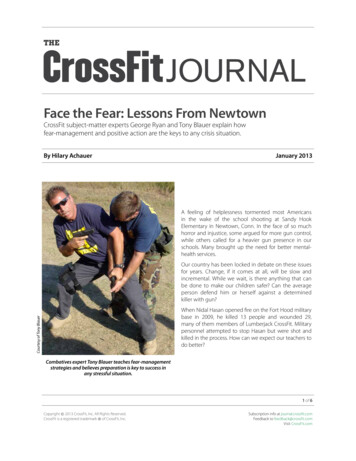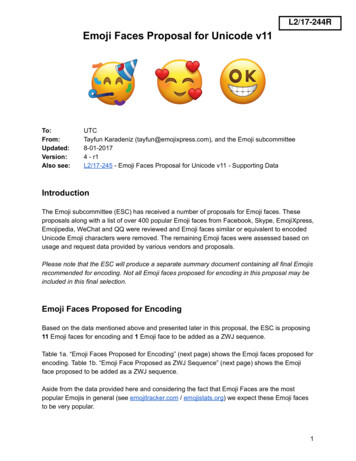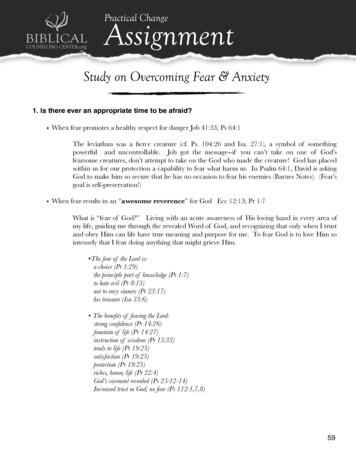
Transcription
Face the Fear: Lessons From NewtownCrossFit subject-matter experts George Ryan and Tony Blauer explain howfear-management and positive action are the keys to any crisis situation.By Hilary AchauerJanuary 2013A feeling of helplessness tormented most Americansin the wake of the school shooting at Sandy HookElementary in Newtown, Conn. In the face of so muchhorror and injustice, some argued for more gun control,while others called for a heavier gun presence in ourschools. Many brought up the need for better mentalhealth services.Our country has been locked in debate on these issuesfor years. Change, if it comes at all, will be slow andincremental. While we wait, is there anything that canbe done to make our children safer? Can the averageperson defend him or herself against a determinedkiller with gun?Courtesy of Tony BlauerWhen Nidal Hasan opened fire on the Fort Hood militarybase in 2009, he killed 13 people and wounded 29,many of them members of Lumberjack CrossFit. Militarypersonnel attempted to stop Hasan but were shot andkilled in the process. How can we expect our teachers todo better?Combatives expert Tony Blauer teaches fear-managementstrategies and believes preparation is key to success inany stressful situation.1 of 6Copyright 2013 CrossFit, Inc. All Rights Reserved.CrossFit is a registered trademark of CrossFit, Inc.Subscription info at journal.crossfit.comFeedback to feedback@crossfit.comVisit CrossFit.com
(continued)Courtesy of Tony BlauerFear .Schools don’t need to get this realistic with their scenario-based training, but Blauer says they should have a plan of action.There are no easy answers, but there are some strategiesthat can help.CrossFit works with two experts who teach civilians, militarypersonnel and law-enforcement officers how to deal withattacks. Tony Blauer, the self-defense expert who runs theCrossFit Defense course, has spent his career teaching fearmanagement and personal-defense readiness through hiscompany, Blauer Tactical Systems. George Ryan, a full-timeSWAT officer and creator of the CrossFit Striking TrainerCourse, has been teaching law-enforcement officersaround the country about proper responses to activeshooter incidents since 1999.Both Blauer and Ryan think there are things we can do.And they say the CrossFit mindset is an important pieceof the puzzle.It wasn’t until he started CrossFit and repeated thoseseemingly simple movements at high intensity for 20minutes that he understood what it felt like.“Prevention and preparationhave made a tremendousdifference in the case of fires.These key principles can beapplied to school shootingsas well.”—George RyanStart With a PlanBlauer said the first time he saw the workout Cindy writtendown, he thought it was a joke. It was before Blauer didCrossFit himself, and when he saw the workout was 5pull-ups, 10 push-ups and 15 air squats for 20 minutes,he said, “Are you guys kidding me? You’re having troubledoing this?”It’s the same with any kind of disaster or survival situation.Teachers and students know what to do in the event of afire because they practice three times a year. In the midstof the panic and confusion, the brain latches onto the planand relaxes.2 of 6Copyright 2013 CrossFit, Inc. All Rights Reserved.CrossFit is a registered trademark of CrossFit, Inc.Subscription info at journal.crossfit.comFeedback to feedback@crossfit.comVisit CrossFit.com
Fear .(continued)“Statistics show that no children have died in a fireat a school in over 50 years,” Ryan said. “This provesthat school fire-safety measures—including the rightequipment, training and drills—are working. Preventionand preparation have made a tremendous difference inthe case of fires. These key principles can be applied toschool shootings as well.”Ryan feels that teachers and school administrators shouldparticipate in scenario-based training that replicates anactive-shooter scenario.“They should involve local law enforcement and use roleplayers. Afterwards, everyone who participates in the trainingshould conduct an honest and thorough debrief to seewhere they can improve. Such training needs to be ongoing,as it will help develop proper conditioned responses to anactual active-shooter event,” Ryan said.In most cases, there is very little time to react. Everythinghappens quickly, and if the teachers and students knowexactly what to do, they will be able to execute the planwithout discussion.“Doing nothing ensures that the worst will happen,”Blauer said.“You can have all the skills in the world, but most peopledon’t shoot well in an ambush,” Blauer said. He believesthe reason the military suffered so many casualties atFort Hood is that they were taken completely by surprise.Blauer said this is a lesson that even people in the militaryneed to learn.Courtesy of Greg AmundsonWhat about the concern that preparing for such an awfuloccurrence would upset the children?“As for drilling the children, schools have long since founda way to put children through fire, lock-down and naturaldisaster drills without causing the children fear and worry,”Ryan said. “The children simply learn do ‘this’ when yourteacher says ‘this’ or when you hear ‘this kind of bell.’”George Ryan (right) believes schools can use scenario-based training to prepare staff for gun-related incidentsjust as they prepare for fires or earthquakes.3 of 6Copyright 2013 CrossFit, Inc. All Rights Reserved.CrossFit is a registered trademark of CrossFit, Inc.Subscription info at journal.crossfit.comFeedback to feedback@crossfit.comVisit CrossFit.com
Fear .(continued)“Just because someone is wearing a uniform, it doesn’tmean they are ready for this type of attack,” Blauer said.The element of surprise is a huge factor, he said. Theshooter in Fort Hood opened fire in a soldier-readinessprocessing center. Not one person expected that, and thesurprise took them all off guard.“Why was Mike Tyson able to bite Evander Holyfield’sear two times?” Blauer asked. “Because of the element ofsurprise. Holyfield was expecting a punch, not a bite.”He added: “The first assault is on the emotional system.”In his seminars, Blauer teaches people to use the body’snatural startle-and-flinch response and adrenaline rush tocreate action.Survival MindsetRyan says that school employees must be willing to call911 even if something just doesn’t look right. Then, ifshooting is taking place, he says the teachers and childrenshould run in the opposite direction of the deadly activityif it’s possible.“After making a quick assessment, the teacher should givethe children concise, easily followed instructions such as,‘Run past the office and then to the crosswalk.’ It is bestif teachers have pre-planned options and instructions forsuch a response,” Ryan said.If schools have a plan,then teachers and childrencan spring into actionand follow that plan.However, if the deadly activity is close to the classroom,teachers need to lock and barricade the door. The childrenmust then be instructed to move away from the entrypoint, stay low to the ground and keep quiet. If there istime, they should draw the blinds and call 911.Blauer agrees. He says that teachers and children shouldbe taught to run away from the threat if they can.Courtesy of Tony BlauerIf we are able to train teachers and school administratorsto keep cool heads and turn fear in to action, what shouldtheir response be if a gunman enters a school?The key is a plan of action, whether that means running away,hiding or playing dead.“You, me and Rich Froning, we can all sprint out the doorequally as fast,” Blauer said.The key is to act quickly.“The cavalry will rush in,” Blauer said. “The question is when?You have to make sure the fear loop doesn’t get you.”Freezing and being unsure of what to do or where to gocan cost valuable seconds. If schools have a plan, thenteachers and children can spring into action and followthat plan.“You need to act,” Blauer said, but action does notnecessarily mean playing the hero.“Maybe the solution is to play dead,” Blauer said. “You haveto combine instincts and intuition. It’s not about chargingthe threat. However, if he does come in the door, youhave to be ready. The survival mindset must precede thesurvival skill set.”Ryan and Blauer agree that if a worst-case scenario occursand a gunman does gain entry into a classroom occupiedby children, the plan needs to be to take action.4 of 6Copyright 2013 CrossFit, Inc. All Rights Reserved.CrossFit is a registered trademark of CrossFit, Inc.Subscription info at journal.crossfit.comFeedback to feedback@crossfit.comVisit CrossFit.com
Fear .(continued)E.M. BurtonRyan has a four-step process he teaches to help peopleremain calm in panic-inducing situations:Blauer advises that teachers and administrators spend timeat a shooting range to give them an idea of the sound andspeed of gunshots.“The form of action will be completely dependent uponthe circumstances, the physical space and the ages of thechildren,” Ryan said.For instance, he said teachers and children can throwanything and everything within their reach at the gunman,including staplers, chairs and coffee mugs.“The intent is to overwhelm and startle that person,” Ryansaid. “The key is to do something—anything—other thanbeing a target. This tactic may seem a little farfetched forsome, but doing nothing is an unacceptable alternative.”Both Blauer and Ryan think teachers and parents can takesteps to mentally prepare themselves for an attack. Ryansays that teachers, staff and administrators can educatethemselves about taking action in the face of fear. Insteadof being overwhelmed and paralyzed by the adrenaline,teachers can learn how to use the body’s natural kickstartfor positive action. The huge surge of adrenaline during acrisis is overwhelming for people who’ve never been in aviolent situation, but your response can be tempered withadrenaline-managing techniques. These techniques canbe used for any situation that provokes fear—including aCrossFit workout.1.Welcome the adrenaline into your body—Think ofthe adrenaline as a power surge and tell yourselfyour body is preparing for success.2.Replace negative thoughts with positive ones—Ifyou hear your inner voice suggesting the situation istoo daunting, replace those thoughts with positiveones immediately. Tell yourself to take positiveaction and repeat it.3.Positive repetitive mantra (PRM)—Choose a simple,positive mantra that you silently repeat in yourmind during a crisis situation to keep you focused.Examples include, “Let’s go” or “I can do this.”4.Deep Breathing—Use deep breathing to helpreduce sympathetic-nervous-system activity. Deepbreathing will not totally eliminate the symptoms,but it will make them more manageable forimproved performance during a crisis event. Breathedeeply in through your nose for a four-second count.Be sure to begin filling your lower lungs first, thenthe middle and finally the top portion of your lungs.Hold for four seconds. Then exhale through yourmouth for a count of four seconds while letting theair out from the top, middle and finally the bottom ofyour lungs. Then repeat. The four-second count canbe changed to a different time period if necessary.The four steps are simple but require constant effort tofight against the body’s natural inclinations.Essential Life SkillsIn addition to mental strategies, both Blauer andRyan have more concrete suggestions to prevent andmanage attacks.“Ideally, school employees should be able to electronicallylock all of the outside doors, and no one should be able toenter the school grounds without checking in and showingID,” Ryan said. “All classroom doors need to remain lockedfrom the inside when children are in the rooms. Doors thatautomatically lock when closed but then automaticallyunlock via a push bar on the inside are one such defensiveoption. Master keys should be made available to teachers,administrators and law enforcement.”5 of 6Copyright 2013 CrossFit, Inc. All Rights Reserved.CrossFit is a registered trademark of CrossFit, Inc.Subscription info at journal.crossfit.comFeedback to feedback@crossfit.comVisit CrossFit.com
Fear .(continued)After talking to one school principal, Blauer thinksadministrators and teachers would be well served bygoing to a range and practicing shooting a gun. This isnot because he thinks teachers should be armed butbecause “they need to know the operating system,”Blauer said. If the school’s plan is that the principalshould access an app on her phone in the event of ashooter, Blauer thinks the principal needs to knowexactly how quickly everything happens when a gunis involved, as well as what actual gunshots sound like.“Dealing with fear,coping with panic andtaking action in a crisisare essential life skills—notjust school-shooting skills.”—George Ryan“We are so weighed down with policy and procedure.When you’re three feet away from the bad guy, you needto fucking move,” Blauer said.The discussion can take on a broader context, becausethe reality is that school shootings are thankfully still quiterare. Moving beyond weapons in schools, parents can usethis opportunity to talk to their kids about taking charge oftheir own safety in general.“Dealing with fear, coping with panic and taking actionin a crisis are essential life skills—not just school-shootingskills,” Ryan said. “These skills can be taught, reiterated andpracticed during life’s littler crises so that children can havesome sense of empowerment in a larger crisis.“If nothing else, parents can teach their children twoessential mantras: ‘3-2-1 breathe,’ because taking abreath helps to control fear and panic, and then ‘3-2-1 go!’ This mantra will remind them to always take action,”Ryan said.Blauer believes that everyone—teachers, office workers,CrossFit athletes—should have the basic tools to behis or her own bodyguard. He calls it indignation or the“how dare you?” state of mind. Rather than freezing whenthreatened, learning a few basic techniques can help youspring into action.“You have to take on the fear and deal with it,” Blauer said.FIf the school does not have a plan in place, should parentstalk to their kids about what to do in the event of a gunmanat school?Ryan says that the emphasis should be on helping kidsvisualize proper responses to a crisis. Then, he said,children can think about how they would distancethemselves from a gunman on the school grounds orbarricade a classroom by summoning help from theirfriends. In addition, parents should instruct their childrento be leaders when a crisis happens.Gary Allard“One of the many tragedies to arise from these horrificincidents is the fact that it now seems inescapable thatwe must educate and prepare our children about schoolshootings,” Ryan said. “Parents should talk to their childrenabout past incidents without overwhelming them withdetailed information. These talks should, of course, betailored to the age and individual temperament of the child.”About the AuthorHilary Achauer is a freelance writer and editor specializing inhealth and wellness content. In addition to writing websites,brochures, blogs and newsletters, Hilary is an editor and writer forthe CrossFit Journal and contributes to the CrossFit Games site.She lives in San Diego and coaches and trains at CrossFit PacificBeach. To contact her, visit HilaryAchauer.com.6 of 6Copyright 2013 CrossFit, Inc. All Rights Reserved.CrossFit is a registered trademark of CrossFit, Inc.Subscription info at journal.crossfit.comFeedback to feedback@crossfit.comVisit CrossFit.com
fear-management and positive action are the keys to any crisis situation. A feeling of helplessness tormented most Americans in the wake of the school shooting at Sandy Hook Elementary in Newtown, Conn. In the face of so much horror and injustice, some argued for more gun control, while others called for a heavier gun presence in our schools.










